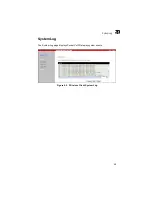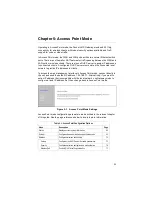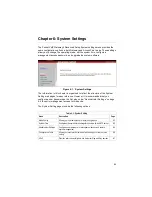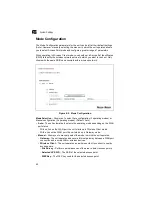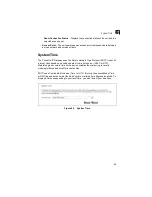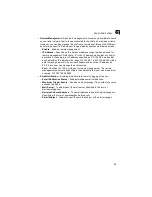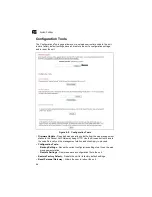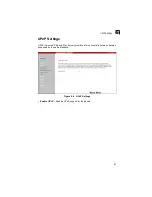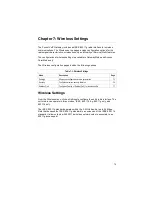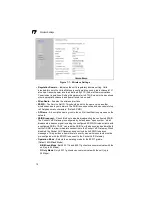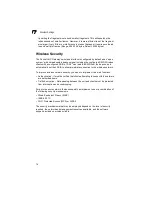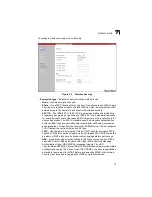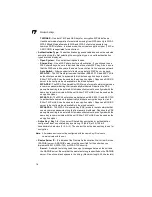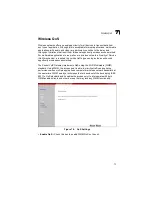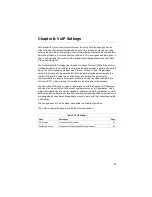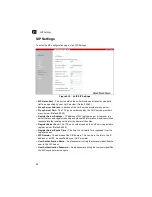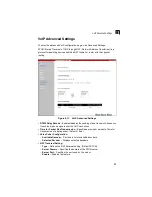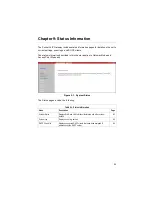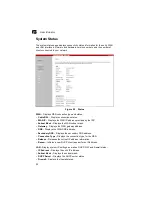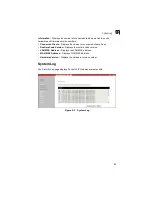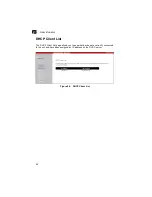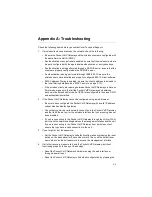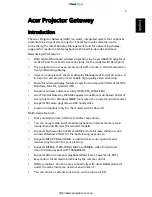
Wireless Settings
7-3
7
-
B Only Mode
: Both 802.11b and 802.11g clients can communicate with the unit,
but 802.11g clients can only transfer data at 802.11b standard rates (up to
11 Mbps).
• Channel ID –
The radio channel used by the unit and its clients to communicate
with each other. This channel must be the same on the unit and all of its wireless
clients. The available channel settings are limited by local regulations. (Default: 6;
Range: 1-14)
Note:
If you experience poor performance, you may be encountering interference from
another wireless device. Try changing the channel, as this may eliminate
interference and increase performance. Channels 1, 6, and 11, as the three
non-overlapping channels in the 2.4 GHz range, are preferred. (Default; Auto)
• Tx Preamble Type –
IEEE 802.11 frames begin with an alternating pattern of 1s
and 0s called the preamble, which tells receiving stations that a frame is arriving.
This provides time for the receiving station to synchronize to the incoming data
stream. This parameter sets the length of the signal preamble that is used at the
start of a data transmission. Using a short preamble (96 microseconds) instead of
a long preamble (192 microseconds) can increase data throughput on the unit, but
requires that all clients can support a short preamble. (Default: Long Preamble)
-
Short Preamble:
Sets the preamble to short for increased througput.
-
Long Preamble:
Sets the preamble to long. Using a long preamble ensures the
unit can support all 802.11b and 802.11g clients.
-
Auto:
Sets the preamble according to the capability of clients that are currently
asscociated. Uses a short preamble if all associated clients can support it,
otherwise a long preamble is used.
• Beacon Interval (20~1000) –
Sets the interval at which Beacon frames are
transmitted from the unit. The Beacon Interval unit is measured in TU, which
corresponds to 1024 microseconds. The beacon signals allow wireless clients to
maintain contact with the unit. They may also carry power-management
information. (Range: 20-1000 TUs; Default: 100 TUs)
• RTS Threshold (0~2347) –
Sets the packet size threshold at which a Request to
Send (RTS) signal must be sent to a receiving station prior to the sending the data
frame. The unit sends RTS frames to a receiving station to negotiate the sending
of a data frame. After receiving an RTS frame, the station sends a CTS (clear to
send) frame to notify the unit that it can start sending data. If the RTS threshold is
set to 0, the unit always sends RTS signals. If set to 2347, the unit never sends
RTS signals. If set to any other value, and the packet size equals or exceeds the
RTS threshold, the RTS/CTS (Request to Send / Clear to Send) mechanism will be
enabled. Units contending for the medium may not be aware of each other. The
RTS/CTS mechanism can solve this “Hidden Node Problem.” (Range: 0-2347
bytes: Default: 2347 bytes)
• Fragmentation Threshold (0~2347) –
Configures the minimum packet size that
can be fragmented when passing through the unit. Fragmentation of the PDUs
(Package Data Unit) can increase the reliability of transmissions because it
increases the probability of a successful transmission due to smaller frame size. If
there is significant interference present, or collisions due to high network utilization,
Summary of Contents for VG007
Page 1: ...www edge core com Management Guide Powered by Accton VG007 Pocket VoIP Gateway...
Page 2: ......
Page 4: ...VG007 F1 0 6 X E012006 R01 150200025600E...
Page 10: ...Figures x...
Page 38: ...Gateway Mode 3 14 3...
Page 48: ...Wireless Client Mode 4 10 4...
Page 58: ...System Settings 6 8 6...
Page 66: ...Wireless Settings 7 8 7...
Page 70: ...VoIP Settings 8 4 8...
Page 82: ...Glossary Glossary 6...
Page 85: ......
Page 86: ...Model Number VG007 Pub Number 150200025600E E012006 R01...

